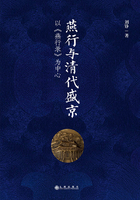we may suppose the plant of which we have been slowly increasing the nectar by continued selection, to be a common plant; and that certain insects depended in main part on its nectar for food. I could give many facts, showing how anxious bees are to save time; for instance, their habit of cutting holes and sucking the nectar at the bases of certain flowers, which they can, with a very little more trouble, enter by the mouth. Bearing such facts in mind, I can see no reason to doubt that an accidental deviation in the size and form of the body, or in the curvature and length of the proboscis, &c., far too slight to be appreciated by us, might profit a bee or other insect, so that an individual so characterised would be able to obtain its food more quickly, and so have a better chance of living and leaving descendants. Its descendants would probably inherit a tendency to a similar slight deviation of structure. The tubes of the corollas of the common red and incarnate clovers (Trifolium pratense and incarnatum)do not on a hasty glance appear to differ in length; yet the hive-bee can easily suck the nectar out of the incarnate clover, but not out of the common red clover, which is visited by humble-bees alone; so that whole fields of the red clover offer in vain an abundant supply of precious nectar to the hive-bee. Thus it might be a great advantage to the hive-bee to have a slightly longer or differently constructed proboscis. On the other hand, I have found by experiment that the fertility of clover greatly depends on bees visiting and moving parts of the corolla, so as to push the pollen on to the stigmatic surface. Hence, again, if humble-bees were to become rare in any country, it might be a great advantage to the red clover to have a shorter or more deeply divided tube to its corolla, so that the hive-bee could visit its flowers. Thus I can understand how a flower and a bee might slowly become, either simultaneously or one after the other, modified and adapted in the most perfect manner to each other, by the continued preservation of individuals presenting mutual and slightly favourable deviations of structure.
I am well aware that this doctrine of natural selection, exemplified in the above imaginary instances, is open to the same objections which were at first urged against Sir Charles Lyell's noble views on 'the modern changes of the earth, as illustrative of geology;' but we now very seldom hear the action, for instance, of the coast-waves, called a trifling and insignificant cause, when applied to the excavation of gigantic valleys or to the formation of the longest lines of inland cliffs. Natural selection can act only by the preservation and accumulation of infinitesimally small inherited modifications, each profitable to the preserved being; and as modern geology has almost banished such views as the excavation of a great valley by a single diluvial wave, so will natural selection, if it be a true principle, banish the belief of the continued creation of new organic beings, or of any great and sudden modification in their structure. On the Intercrossing of Individuals I must here introduce a short digression. In the case of animals and plants with separated ***es, it is of course obvious that two individuals must always unite for each birth; but in the case of hermaphrodites this is far from obvious. Nevertheless I am strongly inclined to believe that with all hermaphrodites two individuals, either occasionally or habitually, concur for the reproduction of their kind. This view, I may add, was first suggested by Andrew Knight. We shall presently see its importance; but I must here treat the subject with extreme brevity, though I have the materials prepared for an ample discussion. All vertebrate animals, all insects, and some other large groups of animals, pair for each birth. Modern research has much diminished the number of supposed hermaphrodites, and of real hermaphrodites a large number pair; that is, two individuals regularly unite for reproduction, which is all that concerns us. But still there are many hermaphrodite animals which certainly do not habitually pair, and a vast majority of plants are hermaphrodites. What reason, it may be asked, is there for supposing in these cases that two individuals ever concur in reproduction? As it is impossible here to enter on details, Imust trust to some general considerations alone.
In the first place, I have collected so large a body of facts, showing, in accordance with the almost universal belief of breeders, that with animals and plants a cross between different varieties, or between individuals of the same variety but of another strain, gives vigour and fertility to the offspring; and on the other hand, that close interbreeding diminishes vigour and fertility; that these facts alone incline me to believe that it is a general law of nature (utterly ignorant though we be of the meaning of the law) that no organic being self-fertilises itself for an eternity of generations; but that a cross with another individual is occasionally perhaps at very long intervals -- indispensable.














